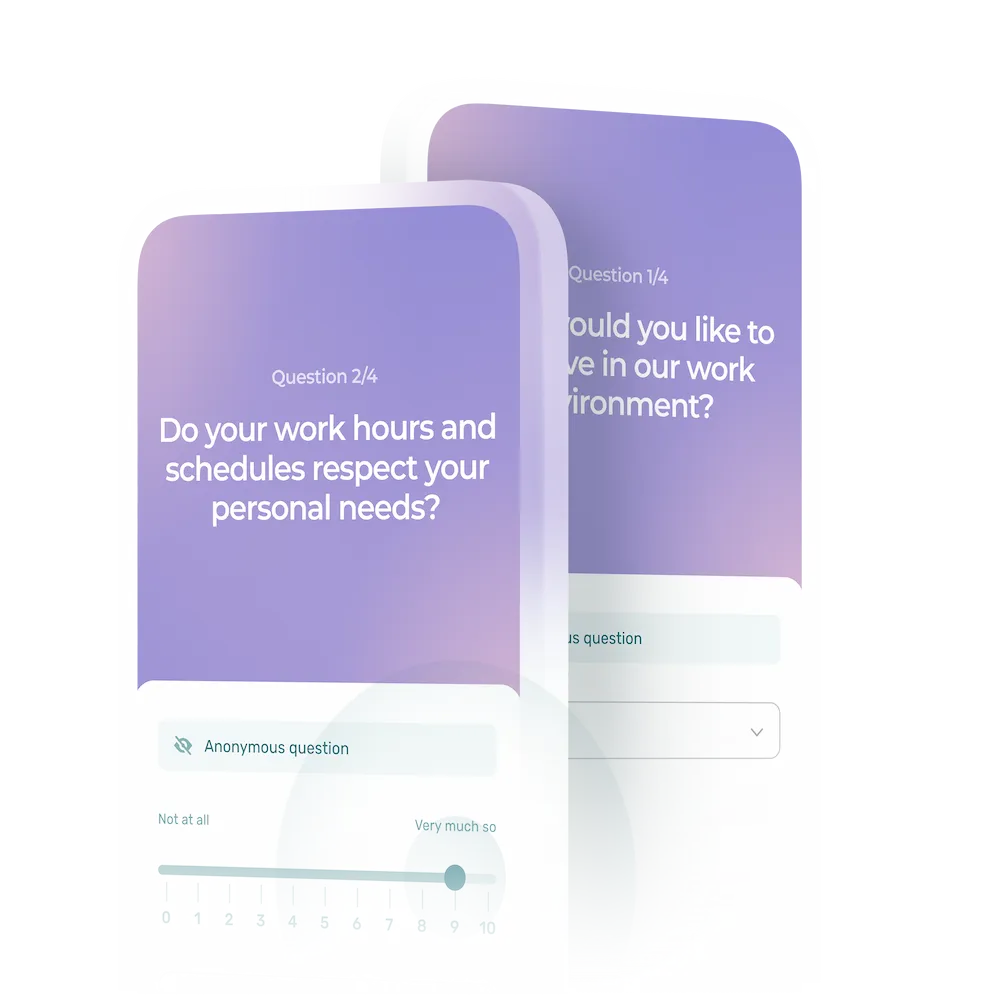Work-life balance is of great importance to employees when it comes to choosing an employer.
In fact, a study completed in 2023 revealed that 62% of employees would be willing to change jobs if they were offered better work-life balance measures.
30% would even accept a wage cut for better working conditions.
So we’ve put together a list of the best tips to help you improve work-life balance in your company.
In this article, you will learn:
- What work-life balance is all about
- How to identify a lack of work-life balance in your company
- Why work-life balance is important
- Dozens of examples of work-life balance measures you can implement in your organization
- How to choose the right work-life measures for your company
What Is Work-Life Balance?
Work-life balance, also sometimes referred to as professional and private life balance, refers to a balance between employees’ professional and personal obligations.
When employees enjoy a good work-life balance, they are able to perform well at work without negatively impacting their personal life. As a result, they achieve fulfillment in all spheres of their lives, and are happier, more rested, and ultimately more successful.
Work-life balance is therefore about achieving a balance between productivity and relaxation, and professional and personal development.
This need for reconciliation is not the same for all employees however. There is no perfect recipe, and each individual must find the right balance for their own needs.
Of course, companies have a very important role to play, since they have the power to directly influence work-life balance.
What Are the Signs of Unhealthy Work-Life Balance?
Signs that a company lacks work-life balance include:
- Employees must work overtime on a regular basis
- Employee turnover is high
- Employee stress levels are high
- Inter-employee conflicts are on the rise
- Many employees are showing symptoms of burnout
- Employees are constantly tired
- Job satisfaction is declining
- Employees have little time for professional and personal development
- Employees are often sick
- Employee productivity declines
Why Work-Life Balance Is Important
Generation Z employees tend to be more concerned about work-life balance. However, regardless of generation, workers are always looking for ways to reconcile their personal and family lives with their professional activities.
And with good reason. Having a good work-life balance brings a ton of benefits, such as:
- Reduced stress
- Better physical and mental health
- A greater sense of accomplishment at work and at home
- An improved feeling of well-being and happiness
- Reduced fatigue
- Increased performance and productivity
- Increased creativity and innovation
Companies that implement measures to offer their employees a better work-life balance also reap multiple benefits such as:
- Improved employee satisfaction
- Reduced absenteeism
- Increased employee loyalty
- Reduced employee stress and fatigue
- Increased employee productivity
- Reduced risk of burnout
- Increased employee performance
- Reduced employee turnover
- Enhanced corporate image and culture
- Improved employee attraction and retention
- Improved employee relations
- Increased diversity and inclusion within the team
- Improved perception of the company by customers and partners
- Reduced costs for recruiting and training new employees
- Building a better employer brand
70 Quick Tips to Promote Work-Life Balance in Your Workplace
- Allowing condensed work weeks: whether by reducing the number of hours per week or condensing work hours, allows employees to have more time to devote to their personal lives
- Providing an allowance for sporting activities: encourages employees to take care of their mental and physical health
- Refunding school fees (in part or in full): encourages employees’ development
- Offer flexible working hours: so that employees can have time for their personal and family obligations
- Using a professional communication tool to communicate with employees to better separate personal and professional life
- Setting up a teleworking policy: flexibility that promotes employee well-being
- Set up an employee assistance program: to help employees through difficult times
- Providing personal days off: because rested employees are productive employees
- Allowing employees to bring their pets into the workplace: creates a healthy, relaxed working environment
- Eliminate overtime: if your employees have to work overtime, it’s probably because you need to hire more
- Update your workforce requirements regularly: to avoid overloading your current employees and create balanced, realistic work schedules
- Hire new employees before your current ones are overloaded: avoid burnout due to excessive workloads
- Create friendly workspaces: stimulate employees’ creativity and allow them to relax during their breaks
- Organize family events or inclusive team-building activities: to strengthen relationships between employees outside the workplace
- Offering childcare in the workplace or refunding childcare costs: making it easier for parents to balance work and family
- Set up a time-banking system for vacations: so that employees know at all times how much time off they can take
- Offer extended maternity and paternity leave: to prevent new parents from returning to work tired and overwhelmed by their new family responsibilities
- Parental guidance and support services: contributing to the well-being of parents
- Introduce flexible policies for medical appointments and family obligations: so that employees don’t feel bad about taking care of their personal responsibilities
- Offer employees a free meal during their shift: so they don’t have to take care of this task on their own time
- Pay for the services of a household helper for employees: so they can devote their free time to something other than household chores
- Buying a property in a tropical country where employees can telecommute 1 week a year with their family: contributes directly to employee well-being
- Giving employees the right to swap shifts easily: greater flexibility for employees
- Giving employees the right to change their availability indefinitely: shows that you understand that their personal lives are important
- Offer more paid time-off than is prescribed by labor laws: to give your employees a better balance between their professional and personal lives
- Offer more sick days: so that your employees don’t feel forced to come to work when they’re not feeling well
- Offering paid training: enables your employees to develop their knowledge
- Offering allowances for employee hobbies: encourages employees to develop outside work
- Offer tickets to sporting events or shows: to enable your employees to spend quality time outside work
- Offer telecommuting and a home office allowance: more flexibility for employees who live far from the office
- Offering yoga or sports classes at lunchtime: encourages a healthy lifestyle
- Building a gym in the workplace: helps reduce stress
- Offer lunch to employees: to ensure they start the day with their bellies full
- Provide access to a video game console in the workplace: so that employees can take advantage of their breaks to unwind
- Offering paid time-off for employees’ birthdays: allows them to spend their birthday doing something they love
- Sharing work schedules in advance: allows employees to better organize their personal schedules
- Offering Friday afternoons off: allows employees to spend more time with their families or attend to personal matters
- Offering massage sessions in the workplace: reduces stress
- Encourage employees to take breaks: so they can rest
- Always offer 2 days off per week: allows employees to spend more time with their families
- Taking employees’ opinions into account: makes it possible to offer more relevant work-life balance measures
- Offering family-friendly benefits: such as family health insurance plans that can be customized to meet individual needs, to ease the financial burden on families and better meet the needs of employees
- Offering part-time work options: allows employees to devote more time to their family or personal life
- Offer sabbatical options: for employees who wish to undertake a project or take a break from work without penalty
- Offer career development opportunities within the company: enables employees to develop their knowledge
- Offer financial planning advisory services: to help employees better manage their personal responsibilities
- Introduce a gradual return-to-work system for parents returning to work after parental leave: makes for a better transition between parental leave and returning to work
- Organize work-life balance awareness events for employees and managers: to provide a healthier work environment
- Offer parent coaching services to help parents better manage the stresses and challenges of parenthood: to give new parents better tools and help them better organize their time
- Set up an in-house mentoring program for parents seeking to progress in their careers while balancing family life: to make new parents feel understood and supported
- Volunteer time off for family and community activities: so that employees can devote themselves to causes close to their hearts
- Organize workshops on time management: helps employees become more organized
- Offering time off to accompany children on their first days of school or daycare: shows that the company supports parents in their new responsibilities
- Providing legal advice on family, financial, and general personal issues: helps employees navigate all their responsibilities
- Offering stress management consulting services: contributes to employee well-being
- Implementing a conflict management training program: helps reduce conflicts and improve the working environment
- Offer work-life balance awareness activities: to ensure that employees understand the importance of finding balance
- Implement a time management system that allows employees to manage their working hours autonomously: to create schedules with open shifts, or let employees determine their own working hours whenever possible
- Offering relaxation or meditation areas in the workplace: encourages employees to take breaks and look after their mental health
- Offering psychological support or counseling services for employees: helps employees better manage their personal and professional challenges
- Encourage disconnected breaks, where employees can step away from their phone or computer: helps employees switch off more easily
- Implement email management policies: limits the constant pressure of communications
- Organize social events or team-building activities outside working hours: to encourage creating ties between colleagues
- Introduce “meeting-free days”: allows employees to focus on their work (best suited to office-type workplaces)
- Set up a program to recognize employees’ personal achievements: encourages employees to develop passions outside work
- Offering a wellness allowance (gym membership, purchase of sports equipment, participation in sports challenges, etc.): encourages employees to pay attention to their physical and mental health
- Organize health and wellness challenges: mobilizes the whole team and strengthen bonds between employees
- Offer sleep and fatigue management counseling services: makes employees aware of the importance of resting
- Offer outdoor activities: encourages employees to spend time outdoors and stay active
- Provide access to a telemedicine service: facilitates access to healthcare for employees
How to Choose the Right Work-Life Balance Measures
Did you know that 49% of Quebec parents don’t take advantage of all the work-life balance measures offered by their employers? In fact, they prefer to do things differently…
This suggests that the measures are not really adapted to employees’ realities, or that their use is not a priority.
Everyone has family and personal obligations. However, the reality for a new parent is not at all the same as for a single young professional. Which is why it’s essential to ask your employees whether the measures offered by the company really suit them. Make sure you use tools that allow you to do this in complete confidentiality, such as online flash surveys.
For example, some employee management software let you create anonymous surveys to send to your employees. This will enable you to better understand their needs and implement the right measures.
Healthy Personnel Management Methods
To ensure the well-being of your employees, it’s essential to offer them optimal working conditions that include better work-life balance measures.
Employees’ lives don’t revolve exclusively around their job. Employers too benefit from offering conditions that enable them to flourish in all spheres of their lives.
And don’t forget to lead by example. If you take steps to reconcile work and family life yourself, your employees will feel more comfortable to do so themselves in the future.










